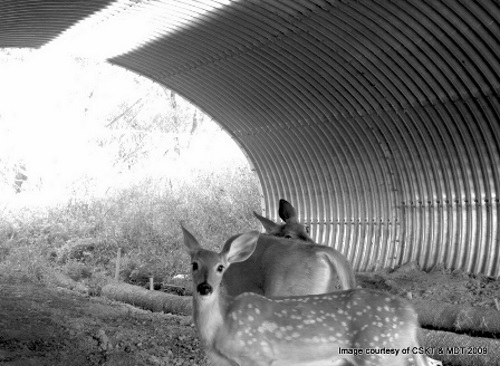The U.S. population has reached 331 million people within nature’s boundary of 2.43 billion acres.
To transportation officials, those big numbers point to a density increase in many parts of the country ― with the ensuing encroachment into natural habitats creating higher chances for fatal motor vehicle crashes between humans and wildlife.
[Above photo from the Oregon DOT.]
However, in areas like Bend, OR, road improvements to U.S. Highway 97 that include a soon-to-be completed $1.2 million under-crossing are tamping down the frequency of such potential tragedies.
It is the third such under-crossing completed along that highway “and we’ve just finished the heavy lifting,” explained Peter Murphy, spokesman for the Oregon Department of Transportation – who added that previous agency projects “resulted in an at least 85 percent drop in crashes” along the four-mile stretch of Highway 97 that intersects the Gilchrist tourist area.
Highway 97, which lies about 25 miles from the peak of the Cascades, was once two lanes but will soon become a partially four-lane artery – equipped in certain sections with 100 feet of new median.
Murphy said the Oregon DOT has moved the dirt, set up the substructure, and poured the concrete for the roadway’s latest under-crossing. “Next comes vegetation removal and installation of a five-mile long ‘funnel’ fence, to channel the animals to the undercrossing,” he added. To the east, deer winter in spots where they find significant solar exposure; to the west, they forage in the slopes on young spring evergreen shoots and grasses.
“Highway 97 intersects their historic habitat, so there are collisions that hurt and kill people and wildlife, as well as damage property,” Murphy explained. “In the wild, thinning the population isn’t the only problem. Mother deer are lost so their fawns are orphaned and they wander aimlessly until they die.”
The progress on Highway 97 is being heralded because, while Oregon “is behind other states” in setting up wildlife access, according to Cidney Bowman, project manager for the Oregon DOT, the agency recently used research from places “like Banff (Alberta) and Montana and applied it to today’s design, which is visually appealing for large ungulates” to use under-crossings safely.
Bowman added that the proper fencing setup is “critical” to the effort, as did Zach Beget, the agency’s bridge designer for the project.
“To me, the biggest lesson learned was ensuring an early alignment was built for the wildlife path,” Beget said. “It was built for the height and width that we wanted. So, if we’re waiting for elk to pass, for instance, then we need a little more room.”
He added that the location of a crossing determines the most economical approach. “In a fill location, you can use the underpass; in a cut location, an overpass works,” Beget said.

The Oregon DOT is also installing gates so personnel will have easy access to inspect the bridge, “which will be valuable when moving equipment, as well as proper excavation below the bridge, to reach the desired height for animals,” he added. “We need to be aware of water elevations.”
Yet the overall process remains straightforward. “It’s not rocket science,” Bowman said. “We just need to make sure the animals will use the crossings by making them large enough and using the fence [which will cost an estimated $750,000] to guide them.”
Such projects cater to creatures not only great, but small, too.
For example, take the Inter-County Connector (ICC), which opened in 2011 in Maryland and includes an expansive wildlife mitigation “package.” A pre-construction survey indicated that the habitat along the 18.8-mile corridor held high concentrations of white-tailed deer; thus, it was built to include more than 40 bridges and culverts to provide safe passage for not only deer and small mammals, but also fish, reptiles and amphibians.
The Wyoming Department of Transportation built eight wildlife underpass structures spanning a 25-mile stretch of Route 89 at a cost of approximately $18 million, “with funding in place” for the next addition, said Scott Gamo, the agency’s environmental services program manager.
The Wyoming DOT is also completing the design of the Dry Piney Project, with in-house sponsorship as well as contributions from Wyoming Game and Fish Department and non-government organizations. “We hope it goes to bid process by this winter,” Gamo said, “with construction hopefully starting in early summer.”
Like Oregon DOT’s Murphy, Wyoming DOT’s Gamo said the results have been solid.
Construction of such under-crossings in Wyoming, he noted, resulted in an approximately 80 percent reduction in collisions. “That’s what we were hoping for” in a state with populations of approximately 400,000 Pronghorn antelope, 350,000 mule deer and 90,000 elk that cross along the state’s 6,700 miles of road, “much of which is through their habitat.”
Gamo added that the crossings “are becoming more common across the country,” noting similar projects in Colorado, Montana, Nevada, and Arizona “that have been very effective.”
Oregon DOT’s Murphy, too, said people in general “see that [building under-crossings] is a good thing and they step up to the table.” He added that there have also been other wildlife crossings in Oregon, “but most were for smaller critters. They typically are not built for bear, elk, and deer. What’s new is that our undercrossing was built for ungulates.” That only makes sense in a locale where wildlife is part of the attraction. “There is a great deal of wildlife in Oregon,” he said. “That’s one reason why people live in and visit our state.”

